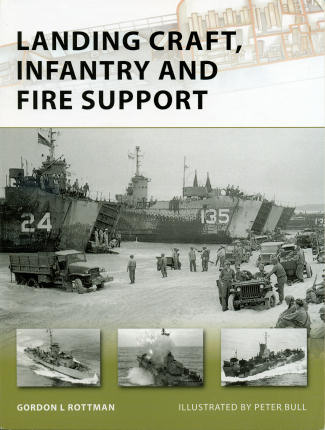 At no other
time in the world's history was the use of sea-borne invasion so great as it was
during World War II. There were literally dozens of events in Europe and in the
Pacific islands that required the invading army to storm the beaches in order to
bring the war to the enemy. This required the use of a variety of landing craft
to haul troops and equipment. During this time, a variety of craft were
developed of all sizes, depending on what was to be transported.
At no other
time in the world's history was the use of sea-borne invasion so great as it was
during World War II. There were literally dozens of events in Europe and in the
Pacific islands that required the invading army to storm the beaches in order to
bring the war to the enemy. This required the use of a variety of landing craft
to haul troops and equipment. During this time, a variety of craft were
developed of all sizes, depending on what was to be transported.
Some were designed to be in the first wave of the
invasion. These were generally somewhat small craft that carried only a limited
number of troops, but were built in large numbers as many were expected to be
lost. Then there were those whose job was to bring ashore larger numbers of
troops once the beachhead was secure. It is in that category that we fit the LCI
or Landing Craft, Infantry. There were two main designs of ship, an early
version with ramps on the side to disembark troops and a later variant that had
a bow ramp similar to that of the large LST. These ships were not designed for
long sea voyages and were only to hold troops for a day or two, but they were
quite useful and successful in their deployment and use.
In fact, so successful were these ships that many of
them were converted to what are basically gun boats. These modified ships
carried either a variety of gun weapons, mostly 20mm and 40mm guns with some
having 3 or 5 inch mounts) or as rocket or mortar ships, capable of putting
hundreds of rounds into the enemy beachhead. These ships were used with great
success to help 'soften up' the beach just prior to the first wave of troops,
and as mobile artillery once these troops were ashore.
Author Gordon Rottman covers the full story of the LCI
and its many different variants. This is further enhanced by a superb choice of
period photos as well as cut-aways of the craft and the outstanding
illustrations of Peter Bull. Though most of these ships were withdrawn from
service after WWII, some saw use during Korea and a few were even brought back
for use in Vietnam. Today, only one LCI and one LCM are still extant as a
tribute to these strudy ships and the service they provided.
All of this and more are contained within the pages of
this excellent reference book that is also a great read. It is one of those that
your editor found to be particularly engaging and I give it my highest
recommendation.
July 2009
For more on the complete line of Osprey books,
visit www.ospreypublishing.com. In the US, it is
Osprey Direct at 44-02 23rd St, Suite 219, Long Island City, NY 11101., where you can
get a catalogue of available books.
If you would like your product reviewed fairly and quickly, please
contact
me or see other details in the Note to
Contributors.
 At no other
time in the world's history was the use of sea-borne invasion so great as it was
during World War II. There were literally dozens of events in Europe and in the
Pacific islands that required the invading army to storm the beaches in order to
bring the war to the enemy. This required the use of a variety of landing craft
to haul troops and equipment. During this time, a variety of craft were
developed of all sizes, depending on what was to be transported.
At no other
time in the world's history was the use of sea-borne invasion so great as it was
during World War II. There were literally dozens of events in Europe and in the
Pacific islands that required the invading army to storm the beaches in order to
bring the war to the enemy. This required the use of a variety of landing craft
to haul troops and equipment. During this time, a variety of craft were
developed of all sizes, depending on what was to be transported.